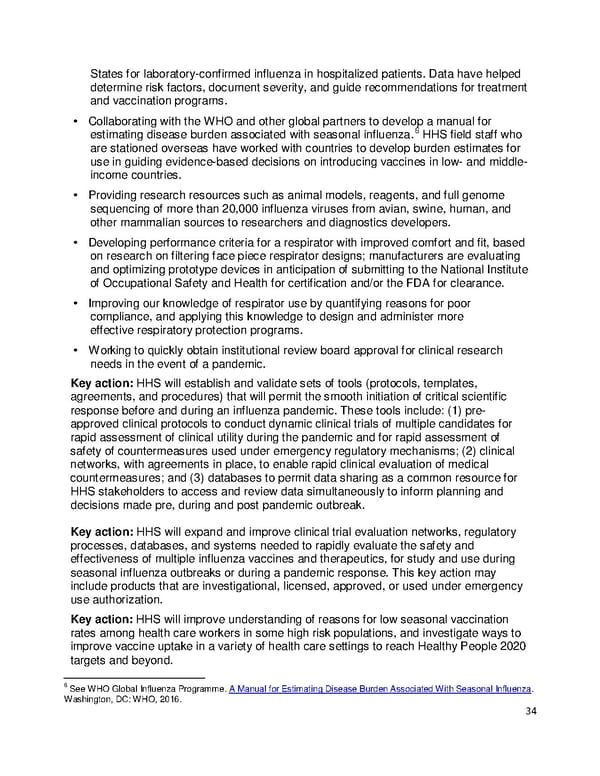States for laboratory-confirmed influenza in hospitalized patients. Data have helped determine risk factors, document severity, and guide recommendations for treatment and vaccination programs. • Collaborating with the WHO and other global partners to develop a manual for 6 estimating disease burden associated with seasonal influenza. HHS field staff who are stationed overseas have worked with countries to develop burden estimates for use in guiding evidence-based decisions on introducing vaccines in low- and middle- income countries. • Providing research resources such as animal models, reagents, and full genome sequencing of more than 20,000 influenza viruses from avian, swine, human, and other mammalian sources to researchers and diagnostics developers. • Developing performance criteria for a respirator with improved comfort and fit, based on research on filtering face piece respirator designs; manufacturers are evaluating and optimizing prototype devices in anticipation of submitting to the National Institute of Occupational Safety and Health for certification and/or the FDA for clearance. • Improving our knowledge of respirator use by quantifying reasons for poor compliance, and applying this knowledge to design and administer more effective respiratory protection programs. • Working to quickly obtain institutional review board approval for clinical research needs in the event of a pandemic. Key action: HHS will establish and validate sets of tools (protocols, templates, agreements, and procedures) that will permit the smooth initiation of critical scientific response before and during an influenza pandemic. These tools include: (1) pre- approved clinical protocols to conduct dynamic clinical trials of multiple candidates for rapid assessment of clinical utility during the pandemic and for rapid assessment of safety of countermeasures used under emergency regulatory mechanisms; (2) clinical networks, with agreements in place, to enable rapid clinical evaluation of medical countermeasures; and (3) databases to permit data sharing as a common resource for HHS stakeholders to access and review data simultaneously to inform planning and decisions made pre, during and post pandemic outbreak. Key action: HHS will expand and improve clinical trial evaluation networks, regulatory processes, databases, and systems needed to rapidly evaluate the safety and effectiveness of multiple influenza vaccines and therapeutics, for study and use during seasonal influenza outbreaks or during a pandemic response. This key action may include products that are investigational, licensed, approved, or used under emergency use authorization. Key action: HHS will improve understanding of reasons for low seasonal vaccination rates among health care workers in some high risk populations, and investigate ways to improve vaccine uptake in a variety of health care settings to reach Healthy People 2020 targets and beyond. 6 See WHO Global Influenza Programme. A Manual for Estimating Disease Burden Associated With Seasonal Influenza. Washington, DC: WHO, 2016. 34
 Pandemic Influenza Plan Page 33 Page 35
Pandemic Influenza Plan Page 33 Page 35